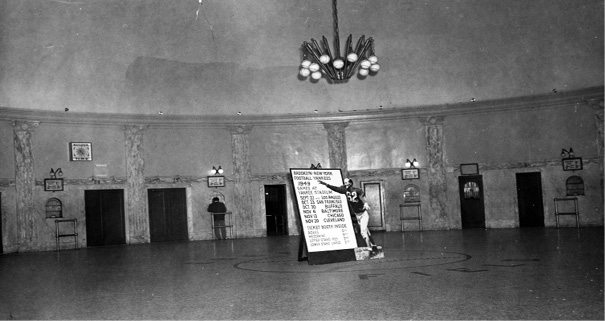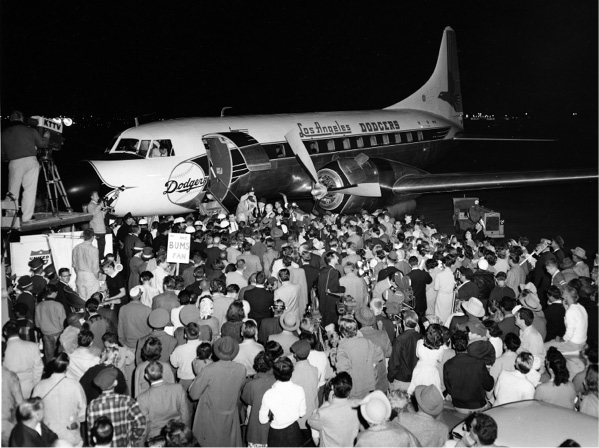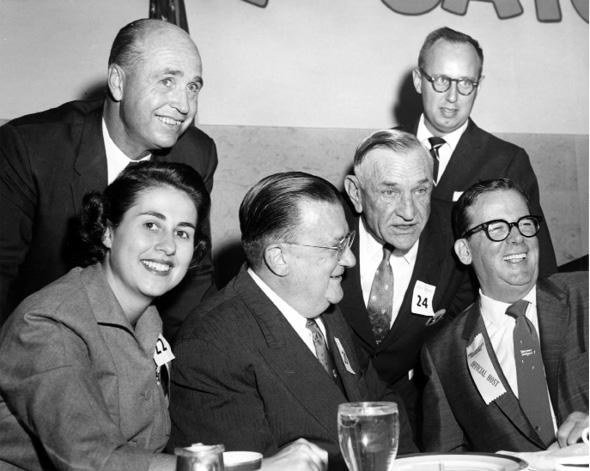100 Things Dodgers Fans Should Know & Do Before They Die (5 page)
Read 100 Things Dodgers Fans Should Know & Do Before They Die Online
Authors: Jon Weisman

8. 1951
Why is it Ralph Branca's fault?
Did Branca spit in the face of caution like Dodgers manager Charlie Dressen, who had famously told the world, “The Giants is dead,” after the Dodgers had built a 13-game lead over second-place New York on August 11 of the 1951 NL pennant race? Did Branca cause the Giants to go on an astonishing 38â8 run, winning 83 percent of their games from August 12 through the end of the season? Did Branca compel Giants reserves Sal Yvars and Hank Schenz to lead an elaborate system of stealing signs that has been determined to have helped the Polo Grounds' home team get any number of hits? Did Branca, who pitched 204 innings with a 3.26 ERA (120 ERA+) do more harm than good for the cause?
No.
It wasn't Branca's fault, after all, that the Dodgers pitching was bone-dry by the end of the season, with Dressen using Branca, Don Newcombe, Preacher Roe, and Carl Erskine for 65 percent of the team's 1,423 innings. One day after pitching 1
1/3
innings in relief as the Dodgers rallied from a 6â1 deficit to a 9â8, 14-inning, season-extending victoryâa game that required Jackie Robinson to spear a bases-loaded line drive in the 12
th
inning to preserve the tie and then homer in the 14
th
to win itâBranca was chosen to start the first game of the three-game playoff with the Giants. Branca pitched eight innings and allowed three runs, but the Dodger offense mustered only one off Jim Hearn and lost.
The next day, Clem Labine got 10 runs of support on a day he didn't need it, shutting out New York to bring the NL pennant to the final game. Despite pitching 23
2/3
innings in the previous week including 14
2/3
in the final two games before the playoff, Newcombe got the start and went 8
1/3
more. And when he needed relief after allowing three hits and a run in the ninth, it wasn't a member of the Dodgers bullpen that got the call. It was, once more into the breach, Branca.
Branca would face Bobby Thomson. Thomson was the hero of Game 1, hitting a two-run homer off Branca in the fourth inning to give New York the lead. Thomson was also, potentially, a goat of Game 3. He inadvertently ran into an out on the base paths in the second inning. With the Giants trailing 2â1 in the eighth inning, the third baseman couldn't handle shots by Andy Pafko and Billy Cox that doubled the Dodger run total.
In recent years, a predominant question has been whether Thomson got a stolen sign for Branca's pitch. Thomson has denied it. For that matter, research by baseball historian Dave Smith has questioned the value of the entire sign-stealing enterprise because the team's overall offensive performance at the Polo Grounds declined after the scheme reportedly began. Branca did come to believe that Thomson had a hint of what was coming.
In the end, did Branca throw a fastball that caught too much of the strike zone, a fastball that Thomson surrounded with his bat like a boy bear-hugging his old man? It was the pitch that gave the Giants a 5â4 victory and the NL pennant, and the Dodgers the most infamous defeat in baseball history. Yes. But in a season that probably saw the Dodgers throw about 20,000 pitches, should the fella whose principal crime was simply throwing the last one be forgiven? No doubt about it.
Â
Â
Â
9. Ebbets Field: The Center Cannot Hold
“Ebbets Field was simultaneously the best ballpark in the world and the worst ballfield for the long-term future of baseball in Brooklyn.” Glenn Stout's Dickensian declaration in
The Dodgers
sums up how the replacement of Washington Park with a brand new ballfield on April 9, 1913, helped foster the diehard Brooklyn fan base while setting the stage for its abandonment.
Like Dodger Stadium, Ebbets Field was more than some seats and a baseball diamond; it had character born of its construction that its fabled residents would later enhance. Ceaselessly visionary, team owner Charles Ebbets wanted a work of art for his team to play in and, in several ways, he succeeded. A rotunda, resplendent with Italian marble, glazed brick, and a grand chandelier (constructed with 12 arms in the shape of baseball bats supporting 12 globes resembling baseballs) greeted visitors. Roman columns and arches provided the support for the grandstand. Ebbets Field felt special from the outset.
But it was such an accomplishment for Ebbets to buy the parcels that would form the ballpark's 4
1/2
acre base (an area that until that point had been a veritable slum popularly known as Pigtown) that he was in denial about how quickly his park would fight against itself, like a baseball bursting from the inside out. The ballpark could not contain the energy it attracted and redoubled. “From the moment ground was first broken, Ebbets Field was an anachronism, one that in each ensuing season would prove to be less and less adequate,” Stout wrote. “That is not to say it was not a wonderful place to watch a baseball gameâit was that and more, a glorious Globe Theater of a place where the mob felt like part of the game, for its cozy dimensions, and double-decked grandstand put fans almost on the field.”
 Â
Â
The entry into Ebbets Field, the vision of Charles Ebbets in 1912, was a large rotunda featuring a marble floor that reads “Ebbets Field” around a large baseball and signature chandelier, made of baseball bats and globes painted with stitching to resemble baseballs. Ebbets Field opened April 9, 1913.
Photo courtesy of www.walteromalley.com. All rights reserved.
Â
In fact, Ebbets Field became a character in its own plays. Extending the second deck around the entire stadiumâwhich was almost all that could be done to increase capacityâhad a catalytic effect on the action within. The dimensions of the playing field shrunk and the slants of the walls, always a physical manifestation of a geometrist's fiendish mind, multiplied. By one count on Ballparks.com, the right-field wall and post-1930 scoreboard offered nearly 300 different angles.
Spiritually, the evolution of Ebbets Field fell in step with the evolution of the Brooklyn baseball franchise, which featured characters like Casey Stengel and Babe Herman along with classic heroes like Zack Wheat and ultimately, the Boys of Summer. There could be no greater emblem for the ballpark than Hilda Chester, a Brooklyn fan with a booming voice and head-ringing cowbell, who wanted nothing more than victory. By the end, Ebbets Field was an acquired taste for some, an annoyance for others.
“There was no escaping the person in the next seat, or the drunk a few rows down,” Brooklyn-born Michael Shapiro wrote in
The Last Good Season.
“The fans' close proximity to the field, which made it possible to talk with outfielders during a pitching change and to hear voices from everywhere in the park, felt as confining as life in a brownstone with neighbors who asked too many questions. Ebbets Field was a row house street, a railroad flat, a kitchen window looking out onto a red brick wall. It was not the way people wanted to live anymore.”
Ebbets Field was built not to last, and you'd have to have blinders not to recognize that some sort of transition needed to be made. Compared to Brooklyn's fading edifice, Wrigley Field and Fenway Park were modern mansions. Ebbets Field was a ticking clock. On September 24, 1957, the Dodgers played their final game there before 6,702 in attendance. In fewer than three years, the ballpark was demolished. While Chavez Ravine in Los Angeles was being transformed from a former residential area into a ballpark, Brooklyn's ballpark was reborn as a 1,300-unit apartment complex, Ebbets Field Apartments.
Â
Â
Hilda Chester
She started by bringing a frying pan to the Ebbets Field bleachers and banging it with a ladle, then graduated to shaking a cowbell. She was the loudest, most raucous fan in Dodgers historyâeven though two heart attacks forced her to abandon her ceaseless razzing of Brooklyn's rivals. Like no one else, Hilda Chester brought on the noise.
“During the games,” wrote Peter Golenbock in Bums: An Oral History of the Brooklyn Dodgers, “Hilda lived in the bleacher seats with her bell. [Leo] Durocher had given her a lifetime pass to the grandstand, but she preferred sitting in the bleachers with her entourage of fellow rowdies. With her fish peddler voice, she'd say, âYou know me. Hilda wit da bell. Ain't it trillin'? Home wuz never like dis, mac.'”
10. The Move
The real history of the Dodgers' move from Brooklyn to Los Angeles is much more nuanced than most people realize, as the following timeline only begins to indicate.
Back in 1946, with Ebbets Field clearly aging, Dodger vice president Walter O'Malley began soliciting ideas for enlarging or replacing the ballpark. Five years of research and investigation passed before, in 1951âa year after gaining majority ownership of the DodgersâO'Malley asked to have the city help assemble land for him to purchase in Brooklyn for the building of a privately financed stadium with parking.
O'Malley directed his request to New York parks commissioner Robert Moses, the biggest hurdle to the Dodgers' continued residence in Brooklyn. In an August 1955 letter to O'Malley, Moses explained the rationale for his opposition, saying that it was not in the public interest to aid the Dodgers in this quest.
“I can only repeat what we have told you verbally and in writing, namely, that a new ball field for the Dodgers cannot be dressed up as a âTitle I' project,” Moses wrote. “If the Board of Estimate on the advice of the Borough President of Brooklyn wants to put through a reasonable sensible plan for highway, railroad terminal, traffic, street, market, and relative conventional public improvements, and incidentally, wants to provide a new Dodgers Field at Flatbush and Atlantic, you can be sure that my boys will fully respect the wishes of the Board and do everything possible to help.”
Flatbush and Atlantic was the location of the deteriorating Fort Greene meat market but also a subway and Long Island Railroad nexus with room for considerable parking as well. It stood as the preferred site among approximately a dozen locations in Brooklyn that were explored for accommodating a new stadium. “Our present attendance studies show the need for greater parking,” O'Malley said in a press release that announced the Dodgers would begin scheduling select regular season games in New Jersey's Roosevelt Stadium in preparation for the inevitable transition out of Ebbets Field. “The public used to come to Ebbets Field by trolley cars, now they come by automobile. We can only park 700 cars. Our fans require a modern stadiumâone with greater comforts, short walks, no posts, absolute protection from inclement weather, convenient rest rooms, and a self-selection first-come, first-served method of buying tickets.”
Â
 Â
Â
The Dodgers made a huge splash upon their arrival to Los Angeles on October 23, 1957, just 15 days after the announcement that they'd leave Brooklyn and head west. Despite a two-hour delay, an enthusiastic crowd anxiously waited for their new professional baseball team.
Photo courtesy of www.walteromalley.com. All rights reserved.
Â
O'Malley argued that these weren't luxuries, but necessities. “Baseball, with its heavy night schedule, is now competing with many attractions for the consumer's dollar and it had better spend some money if it expects to hold its fans,” he said, “Racing has found a way to get State legislation and financing for a super-colossal proposed race track. I shudder to think of this future competition if we do not produce something modern for our fans. We will consider other locations only if we are finally unsuccessful in our ambition to build in Brooklyn.”
In the coming months, the Dodgers won their first World Series, and O'Malley got his first look at a model of a domed stadium that, if given the space, would address the needs of baseball in Brooklyn. In April 1956, with the support of New York mayor Robert Wagner and 100 civic leaders, Governor Averell Harriman raised hopes for a Brooklyn solution by signing into law the creation of the Brooklyn Sports Center Authority “for the purpose of constructing and operating a sports center in the Borough of Brooklyn at a suitable location.”
But the momentum soon fizzled.
Three years earlier, Roz Wyman, running in part on a campaign to bring baseball to Los Angeles, became the youngest person ever elected to the L.A. City Council. The following year, the council wrote to Major League Baseball's owners asking them to consider moving a team there. None of this had the slightest significance until dreams of a new Brooklyn ballpark began to fade before the year was out. A decade after O'Malley had begun trying to address the demise of Ebbets Field, a cross-country move emerged as an option. Almost as if to give the Dodgers a little push, Moses recommended that the city of Brooklyn excise the proposed stadium from the redevelopment of downtown Brooklyn.
Moses did have an idea for keeping the Dodgers in New York, however, and proposed to throw support to a 50,000-seat stadium in Flushing Meadows, the geographic center of Queens. O'Malley visited the site and said afterward it had “possibilities.”
“To me it has a chance, [but] there are obviously some deterrents,” he wrote in another internal document. “Rapid transit facilities are minimum.⦠Grand Central Parkway is already bumper to bumper but the future might mean widening. The site would be more acceptable to Westchester and Queens people than to Brooklynites. There is no well-defined network of buses serving the area. We might get by on the parking but it would be minimum with little likelihood of being expanded to maximum requirements.”
Â
 Â
Â
On October 28, 1957, the Dodgers attended a civic luncheon welcoming them to their new home, Los Angeles. Dodgers owner Walter O'Malley (center) is joined with Rosalind Wyman, the L.A. City Councilmember most responsible for encouraging the Dodgers to relocate, and Los Angeles mayor Norris Poulson. Standing behind them are Dodgers manager Walter Alston (left), former Dodgers player and manager Casey Stengel (middle), and an unidentified man (right).
Photo courtesy of www.walteromalley.com. All rights reserved.
Â
Also discouraging was the fact that the site was on swampland that, according to Emil Praeger, past designer of Holman Stadium in Vero Beach and future designer of Dodger Stadium, would make securing the proposed ballpark's foundation a challenge.
Meanwhile, numerous other cities, from Oakland to Dallas, soon began making inquiries regarding the Dodgers. The ensuing issue, which remains open to debate, is this: Should O'Malley have shown favoritism to a site that was in New York but not in Brooklyn? He chose not to. “If the Dodgers would have to go out of Brooklyn any site would have to be weighed against such available locations such as Los Angeles,” he wrote in an April 1957 internal memo. “In other words, the Brooklyn Dodgers would not be Brooklyn anywhere else.”
Within a month, O'Malley was the terrified single passenger in an open-door helicopter above Los Angeles, examining potential sites for a ballpark. He saw from overhead the Chavez Ravine site that was among those he had been told about for years, a site offering ample room to build and access to the freeways converging to nearby downtown. As O'Malley's interest in Los Angeles grew, the New York Giants were also closing in on a West Coast move to San Francisco. By the time the Giants made their formal announcement in August, further research had convinced O'Malley that Los Angeles was superior to Queens.
To the end, O'Malley still favored staying in Brooklyn over any kind of move out of town, but Moses would not pull the strings to make the Flatbush and Atlantic site available. On October 7, 1957, the L.A. City Council officially approved the contract agreed to on its behalf by lead negotiator Chad McClellan, and the following day, citing the aging Ebbets Field, insufficient parking, dwindling attendance, and a 5 percent New York City admissions tax, O'Malley announced the Dodgers' intention to move.
If it's true that O'Malley sought a stadium outcome that would be best for his franchise and its financial well-being, it's also true that Moses stood firmly in the way of what the people of Brooklyn professed to desire. O'Malley never wavered from his willingness to pay for the land in Brooklyn and the stadium that he would erect upon it, if only the site would be made available for purchase. Though it was ultimately O'Malley's decision for the Dodgers to leave the City of Churches, Moses and other officials gave them little reason to stay.